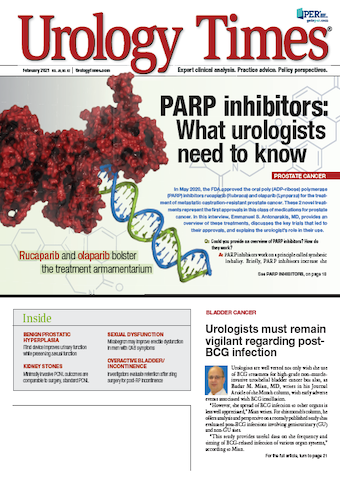Publication
Article
Urology Times Journal
PARP inhibitors and prostate cancer: What urologists need to know
Author(s):
In this interview, Emmanuel S. Antonarakis, MD, provides an overview of rucaparib (Rubraca) and olaparib (Lynparza), discusses the key trials that led to their approvals, and explains the urologist’s role in their use.
Emmanuel S. Antonarakis, MD

In May 2020, the FDA approved the oral poly (ADP-ribose) polymerase (PARP) inhibitors rucaparib (Rubraca) and olaparib (Lynparza) for the treatment of metastatic castration-resistant prostate cancer. These 2 novel treatments represent the first approvals in this class of medications for prostate cancer. In this interview, Emmanuel S. Antonarakis, MD, provides an overview of these treatments, discusses the key trials that led to their approvals, and explains the urologist’s role in their use. Antonarakis is a professor of oncology and urology at the Johns Hopkins Sidney Kimmel Comprehensive Cancer Center in Baltimore, Maryland. Antonarakis has served as a paid advisor to AstraZeneca, Merck, Clovis Oncology, Janssen, and Pfizer.
Could you provide an overview of PARP inhibitors? How do they work?
PARP inhibitors work on a principle called synthetic lethality. Briefly, PARP inhibitors increase the amount of DNA damage in the cancer cell. As a general principle, a little bit of DNA damage is a good thing for a cancer cell; it helps it survive and metastasize and grow more rapidly and proliferate. But too much DNA damage can be a bad thing because it can lead to catastrophic genomic instability and subsequent cancer cell death.
PARP inhibitors work best in cancers that have mutations in homologous recombination repair (HRR) genes. The most well-known of these in prostate cancer is BRCA2. BRCA2 is a gene (and a protein) that is responsible for fixing double-strand DNA breaks. There is another way that cancer cells can fix DNA breaks, which is called single-strand repair, fixing 1 DNA strand at a time. So if you have a patient with a BRCA2 mutation, that cancer cell’s ability to fix double-strand DNA breaks is impaired. It then relies on the other pathway, the single-strand repair pathway, to fix its DNA damage. That single-strand repair pathway is done by an enzyme called PARP, primarily PARP1. If PARP1 is inhibited by a drug, such as a PARP inhibitor, in a patient who already has a mutation in the alternative mechanism of DNA repair—in other words, BRCA2—then that cancer cell develops catastrophic DNA damage, so that the next time it replicates it’s not able to survive and it dies.
Again, this concept is synthetic lethality. It simply means that you need a one-two punch to kill the cancer cells. The first punch comes from the genetic mutation that the cancer has, and the second punch comes from the PARP inhibitor, leading to catastrophic DNA damage in the cancer cell and subsequent cell death.
Please discuss the key findings from the TRITON2 (NCT02952534) and PROfound (NCT02987543) clinical trials of rucaparib and olaparib.
In May 2020, there were 2 FDA approvals for PARP inhibitors in prostate cancer within 5 days. The first was rucaparib, a PARP inhibitor approved based on a phase 2 single-arm study without a control group, called TRITON2. The TRITON2 study, in an unprecedented way, led to FDA approval of a drug in prostate cancer without requiring randomization and without having a control group. However, it was an accelerated FDA approval, meaning that full approval by the FDA is contingent upon a positive phase 3 randomized study (TRITON3 [NCT02975934]), which is ongoing.
TRITON2 evaluated patients who had 1 or more DNA repair gene mutations. The 2 genes of greatest interest were BRCA1 and BRCA2, and then there were a handful of other, more rare genes included as well. Patients had to have either germline mutations within 1 of those genes, or somatic mutations in a tumor in 1 of those genes. They then received rucaparib twice daily. The primary end point of the study was not overall survival or progression-free survival like other studies that we have seen, but rather the objective response rate. A secondary end point was the prostate-specific antigen (PSA) response rate. Approximately 40% of patients with a BRCA1 or BRCA2 mutation who received rucaparib had an objective response, and the PSA response rate was even higher at about 50%. The efficacy in the other non-BRCA genes was less impressive, and Clovis Oncology, the company making rucaparib, decided not to seek FDA approval for any of the other genes. Thus, the accelerated approval for rucaparib, granted in May of 2020, was only for patients with germline or somatic BRCA1 or BRCA2 mutations. The other small but important point is that the TRITON2 study required patients to have metastatic castration-resistant prostate cancer, and they had to have disease progression despite previously receiving at least 1 novel hormone therapy and 1 chemotherapy. The accelerated FDA approval reflected that patient population, meaning that patients who are eligible to receive this drug (now that it has been approved) should have previously received both a novel hormone agent plus a chemotherapy agent.
The second trial, which was the PROfound (NCT02987543} study, led to the full FDA approval of olaparib. This was a phase 3 randomized study for patients with a genetic mutation in BRCA1, BRCA2, ATM, or 12 other genes. The primary end point of interest was radiographic progression-free survival for patients with either BRCA1, BRCA2, or ATM mutations. A key secondary end point was overall survival in this cohort. Patients with metastatic castration-resistant prostate cancer who had received at least 1 novel hormone therapy, plus up to 1 chemotherapy (although the chemotherapy was not mandated), were randomized to receive either olaparib or a physician’s choice of hormonal therapy. The trial was positive, showing a significant prolongation of radiographic progression-free survival but also overall survival in the patients who had BRCA1, BRCA2, and ATM mutations.
As a prespecified secondary analysis, the trial was also powered to evaluate the overall patient population that included patients with mutations in any of the 15 HRR genes, not just the 3 mentioned above. In that entire study population, there was also a prolongation of radiographic progression-free survival with olaparib compared with placebo. This led the FDA to approve olaparib for not just the BRCA1, BRCA2, and ATM genes, but also various other HRR genes, including CHEK2, PALB2, CDK12, and several others.
What genetic testing is needed to determine a patient’s eligibility for treatment with a PARP inhibitor?
Patients with prostate cancer who are eligible for treatment with a PARP inhibitor have to have either a germline or somatic mutation in 1 or more of the DNA repair genes. In the case of olaparib, the range of genes is more expansive and includes 14 genes, including but not limited to BRCA1, BRCA2, ATM, CHEK2, PALB2, and CDK12. There are a few others as well. However, in the case of rucaparib, the treatment is restricted to patients who have either germline or somatic BRCA1 or BRCA2 mutations only. At this time, rucaparib cannot be recommended for patients with non-BRCA mutations.
Germline genetic tests can be done using saliva or peripheral blood leukocytes. Somatic genetic testing requires a tumor sample, either a metastatic tumor biopsy or an archival primary prostatic biopsy. In addition, there are now several commercial circulating tumor DNA assays that can assess tumor DNA using a blood test.
How will urologists be involved with the administration of PARP inhibitors?
In general, the prescriptions of these agents will mostly be coming from medical oncologists. However, urologists do have an important role in identifying patients for potential eligibility for PARP inhibitors down the line; for example, patients with germline mutations in BRCA2 will become eligible for PARP inhibitor treatment if they eventually develop metastatic castration-resistant disease. Unlike somatic genetic testing, which is currently only recommended in the National Comprehensive Cancer Network guidelines for patients with metastatic disease, germline testing is recommended for patients with nonmetastatic prostate cancer as well; for example, if they have intermediate- or high-risk localized prostate cancer, if they have any type of localized prostate cancer with a family history of prostate, breast, or ovarian cancers, or if they have an ancestral Ashkenazi Jewish background.
If patients who don’t yet have metastatic or castration-resistant prostate cancer are identified by a urologist as having a germline mutation in a gene such as BRCA2, then those patients could be prioritized prospectively for future treatment with a PARP inhibitor as soon as they become eligible, rather than trying to scramble and get a biopsy of metastatic tissue after the patient has already developed castration-resistant prostate cancer, where some time may be lost in planning for PARP inhibitor treatment.
The other interesting thing is we are now seeing studies evolving in the neoadjuvant space and adjuvant space, where PARP inhibitors are being investigated in an experimental fashion for patients who have mutations in 1 of these HRR genes. So it is likely that several urologists across the country may have access to 1 of these neoadjuvant or adjuvant or early biochemical recurrence studies that are incorporating a PARP inhibitor in an investigational fashion for patients with prostate cancer harboring germline or somatic HRR mutations.
What adverse effects should urologists be particularly mindful of when a patient receives a PARP inhibitor, and how are these effects optimally managed?
The adverse effects of PARP inhibitors are broadly similar and overlapping. They include fatigue, nausea, anorexia, and suppression of blood counts, especially platelets and white blood cells. Fatigue is usually self-limiting and does not require intervention, although sometimes a dose reduction may be needed. Anemia, in most cases, is also relatively asymptomatic, although in some patients, it can result in fatigue or dyspnea, or other clinical symptoms. In about 15% of patients, anemia can be severe enough to warrant a red blood cell transfusion. We also need to keep a close eye on the renal function of patients, especially creatinine level, because these drugs, as a class, can cause an elevation of creatinine.
There is 1 adverse effect that is specific to olaparib that does not appear to be present with rucaparib, and that is a dry cough. Olaparib is associated with a cough in about 5% of patients. The cough disappears when the drug is stopped and often reappears if the drug is introduced again, even in a lower dose. Also, there have been case reports of a rare but serious pneumonitis (inflammation of the lung), which again can rarely occur with olaparib, but has not been seen yet with rucaparib. Olaparib may also be associated with a slight predisposition to venous thromboembolic complications, such as deep vein thrombosis and pulmonary embolism.
Finally, these drugs all have a theoretical and real (but small) risk of either accelerating or inducing myelodysplastic syndromes and potentially even acute myeloid leukemia. In patients who are older and already have preexisting myelodysplasia, these drugs should probably be avoided. If there is any evidence of a myelodysplastic syndrome, these patients should see a hematologist who specializes in myelodysplasia and should discontinue PARP-inhibitor treatment.
Can you discuss the next steps for PARP inhibitors and prostate cancer, including combination therapy trials of PARP inhibitors with immunotherapies or androgen receptor (AR) pathway inhibitors?
There are at least 2 future directions for PARP inhibitor treatments. One is to combine these agents with other standard therapies for metastatic prostate cancer. We have been using drugs such as abiraterone acetate [Zytiga] and enzalutamide [Xtandi] for almost a decade now. These are natural combination partners with PARP inhibitors. There are a number of pivotal phase 3 studies that could lead to FDA approval of these combinations. For example, there is TALAPRO-2 (NCT03395197), a phase 3 randomized study of talazoparib plus enzalutamide versus enzalutamide alone in patients with metastatic castration-resistant prostate cancer.
In addition, there is also the MAGNITUDE (NCT03748641) trial, a phase 3 randomized study evaluating niraparib plus abiraterone in patients with metastatic castration-resistant prostate cancer. The goal of those studies is to see whether the combination of a PARP inhibitor and a novel hormonal therapy might be successful in genetically-unselected patients; in other words, not just patients who might have 1 of these HRR gene mutations.
PARP inhibitors are also being studied in the metastatic hormone-sensitive setting. The recently launched AMPLITUDE trial (NCT04497844) is a phase 3 randomized study of abiraterone plus niraparib versus abiraterone alone (in combination with standard androgen deprivation) in patients with metastatic hormone-sensitive prostate cancer who have a genetic mutation in 1 of these HRR genes. So that one is a biomarker-selected design.
The second future direction is the combination of PARP inhibitors with immunotherapies, such as PD-1 inhibitors. There are a number of phase 3 studies that are either being designed or are currently enrolling patients. One example is the KEYLYNK-010 (NCT03834519) study, a phase 3 randomized trial of olaparib plus pembrolizumab versus either enzalutamide or abiraterone in patients with metastatic castration-resistant prostate cancer who have received 1 novel hormonal therapy and 1 taxane chemotherapy. That study is expected to read out in 2022.
Some experts have said that the approval of PARP inhibitors marks the dawn of the precision medicine era in prostate cancer. In your opinion, where does precision medicine go from here in the prostate cancer treatment paradigm?
The modern definition of precision medicine often involves a genetic or genomic test identifying a particular mutation that then leads to a vulnerability of cancer to a particular drug. I would argue that precision medicine in prostate cancer started 50 or more years ago because the AR is 1 of the prototypical oncogenes that we have been targeting in this disease for a long time.
In my opinion, we have at least 2 examples of precision medicine in prostate cancer thus far, but we are still way behind other cancers such as lung and breast. The first example came in 2017 when the FDA approved pembrolizumab for any patient of any cancer type with a mismatch repair gene mutation or microsatellite instability-high genotype. However, only 3% to 4% of prostate cancers have mismatch repair deficiency or microsatellite instability. A more recent example of precision medicine came in May of 2020, with the approval of rucaparib and olaparib for HRR-mutated or BRCA1/BRCA2-mutated prostate cancer.
There are additional examples of precision medicine treatments in the pipeline. There are drugs that inhibit the AKT pathway or the PI3-kinase pathway that might be efficacious in prostate cancers with either deletion or mutation in PTEN or with activation of PI3-kinase or AKT pathways. One example is the drug ipatasertib (an oral AKT inhibitor), which has been tested in patients with PTEN loss and may lead to FDA approval in those patients based on the positive results of the IPATential150 (NCT03072238) trial.

































